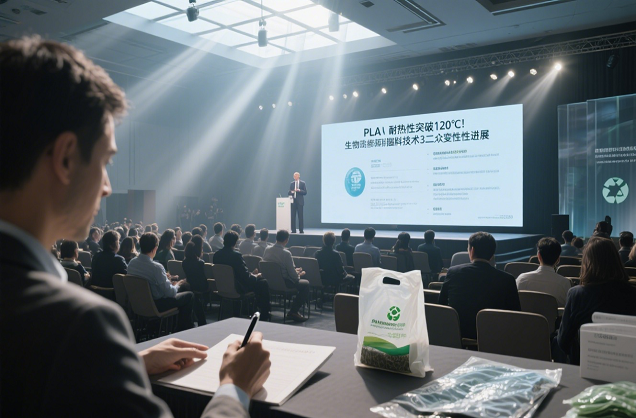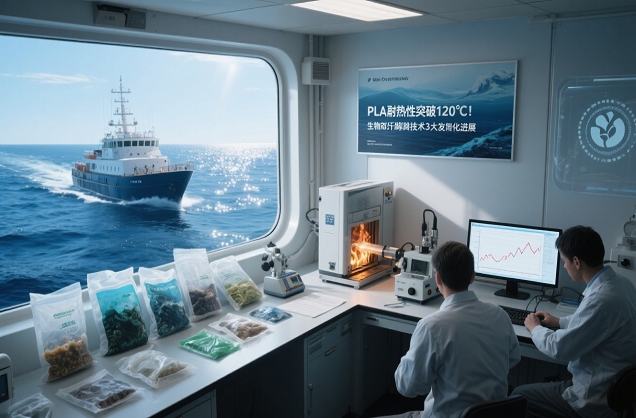PLA heat resistance exceeds 120°C! 3 Disruptive Advances in Biodegradable Film Technology
The year 2024 brings great news to the materials science community – Corbion, the world’s leading bioplastics company, has successfully developed a fourth-generation PLA (polylactic acid) material that is heat-resistant up to 120 degrees Celsius, breaking through the technological bottleneck in high-temperature application scenarios for biodegradable films. This milestone progress enables PLA films to replace more than 90% of traditional petroleum-based plastic packaging.

I. Three major technological breakthroughs in heat-resistant PLA
1. Stereo composite core technology (breakthrough point 1)
Technical principle: through the precise pairing of levo-(PDLA) and dextro(PLLA) lactic acid molecules to form a high degree of stereocomposite crystals.
Key Data:
Heat distortion temperature increased from 60°C to 118°C
Crystallinity of 50% (ordinary PLA only 30%)
Microwave oven resistance test passed 1000 cycles
Application scenarios: hot drink cup lids, microwave food packaging, protective film for electronic components
2. Nanocellulose reinforced technology (Breakthrough point 2)
Innovative process:
Adopt cellulose nanowhiskers with 2-5nm diameter
Surface grafted PLA compatibilizer
Three-dimensional network structure enhancement
Performance enhancement:
Tensile strength 85MPa (close to PET film)
Thermal expansion coefficient reduced by 40%
Light transmittance maintained at 92% or more
Typical case: Toyota Boshoku Japan has been used in automobile interior parts.
3. Multi-component synergistic stabilization technology (breakthrough point 3)
Formulation system:
Organic rare earth heat stabilizer (0.3-0.5%)
Phosphate ester anti-hydrolysis agent
Vitamin E derivative antioxidant
Durability test:
Strength retention rate >95% after aging at 120℃/100h
5 times longer service life under hot and humid environment (85℃/85%RH)

II. Performance Comparison with Traditional Materials
Performance indicators Fourth-generation PLA Ordinary PLA PP plastic Comparison of advantages
Heat distortion temperature (℃) 118 55 105 First time to surpass polypropylene
Tensile strength (MPa) 85 60 35 Leading mechanical properties
Oxygen permeability (cc/m²-d) 120 150 2500 Freshness improvement by 2 times
Degradation time (months) 6-12 12-24 400+ Maintains degradable properties
Carbon Footprint (kgCO₂/kg) 1.8 2.0 3.5 Significant Environmental Advantages
III. Three major application areas to be subverted
1. High-temperature food packaging revolution
Ready-to-eat lunch box: 121 ℃ steam sterilization resistance, has been approved by the FDA food contact certification
Coffee capsules: Switzerland’s Nespresso announced a full switch in 2025
Bakery packaging: resistant to oven 230 ℃ / 15 minutes of short-term heating
2. Expansion of applications in the electronics industry
Flexible Circuit Substrate: Reflow Resistance (260°C/10 sec) up to standard
Battery Separator: Controllable porosity (30-70%), excellent thermal shutdown characteristics.
Optical film: passed 2000 hours of high-temperature and high-humidity environment test.
3. Automotive parts innovation
Interior skin: high temperature resistance (110℃) without deformation of the instrument panel
Wiring harness packaging: UL94 V-0 flame retardant grade
Temporary protective film: easy to peel off after spraying and drying (80-100℃).

IV. Industry Chain Impact Analysis
1. Demand for equipment modification
Injection molding machine: temperature control system needs to be upgraded to 200°C
Mold: shrinkage rate adjusted to 1.2% (ordinary PLA is 1.8%)
Drying system: dew point requirement <-40℃ (waterproof sub-degradation)
2. Cost-effective calculation
Item Fourth generation PLA food grade PP Difference
Raw material cost ($/kg) 3.8 1.5 +153% – Advantages
Processing energy consumption 15% lower – Advantage
Recycling value Composting revenue Degraded recycling Advantage
Brand premium 20-30% – Significant

V. Technical Challenges and Solutions
1. Three existing bottlenecks
Narrow processing window: Melt strength is 30% lower than PP.
High raw material purity requirement: D-lactic acid content needs to be <0.5%.
Conflicting recycling systems: cannot be mixed with PET recycling streams.
2. Latest solutions
Specialized chain extender: BASF launched Joncryl ADR-4468 to improve melt strength.
Stereospecific catalyst: CAS develops new zinc complex to control isomer content
Digital Watermarking: HolyGrail 2.0 Project Automates Sorting
If you have any questions you want to know, please feel free to come and consult, and we will be eager to answer them for you.
Contact us now
Fill out the form below
We will contact you immediately.

Summarize your business so the visitor can learn about your offerings from any page on your website.
About
Contact
- Add: Room 4006, No.1 Helong Yiheng Road, Baiyun District, Guangzhou City
- Tel: +8613450255948
- Wechat : +86-13450255948
- Fax: +86-13450255948
- E-mail: 13450255948@163.com
